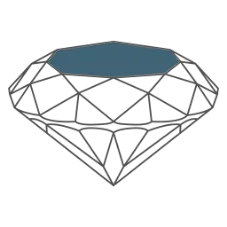Anatomy
Diamond Anatomy

A diamond is a precious natural gemstone formed from carbon. Nature applies the appropriate pressure, High Temperatures and time for the carbon to transform in structure. As a result, the crystal is beautiful, clear, and generally colourless. The most valuable diamonds are as close to this description as possible. The highest value diamonds are those that come closest to this ideal description, as they are clear, brilliant crystals and free of visible impurities (for the most part, more on this later), as well as being remarkably large. Although smaller diamonds can be fascinating, it is the larger stones that communicate an essential statement of luxury and prestige.
Every diamond is unique, but it shares some fundamental structural characteristics. The anatomy or basic structure of a diamond influences its proportions, brilliance, light dispersion, and sparkle. Understanding each component of a diamond and how it contributes to the stone’s overall appearance will help you locate the perfect diamond for you. A diamond is made up of major components Table, Crown, Girdle, Pavilion, Depth, and Culet are the dimensions. Below, we provide a brief description of each part of a diamond and its importance in determining its beauty and value.
Every diamond is unique, but it shares some fundamental structural characteristics. The anatomy or basic structure of a diamond influences its proportions, brilliance, light dispersion, and sparkle. Understanding each component of a diamond and how it contributes to the stone’s overall appearance will help you locate the perfect diamond for you. A diamond is mainly composed of six main components: Table, Crown, Girdle, Pavilion, Depth and Culet, each with specific dimensions and positions. Below, we provide a brief description of each part of a diamond and its importance in determining its beauty and value.
Main Parts Of A Diamond
Table
- The upper most flat surface on the superior portion of the diamond
- It runs parallel to the plane of the girdle.

Crown
- The whole portion above the girdle line on a diamond.
- The facets above the girdle and table are all part of the diamond crown.

Pavilion
- The portion of the diamond beneath the girdle.
- This element impacts how the diamond will interact with light.
- Well cut pavilion will allow the maximum amount of light to reflect from the surface of the diamond.

Girdle
- The widest part of the diamond where the crown meets the pavilion.
- This area may have facets or may be smooth.

Culet
- The culet is the small area at the bottom of a diamond’s pavilion.
- It can be a point or a very small facet sitting parallel to the table.

Depth
- When viewed from the side, a diamond’s depth is the distance from culet to the top of the table. Basically depth % refers to the height of a diamond.
- Depth is measured in millimetres and percentage.
- The depth % of a diamond can be achieved by dividing the depth by the width. The ratios and sizes of a diamond’s depth are one of the main factors impacting diamond cut quality.

